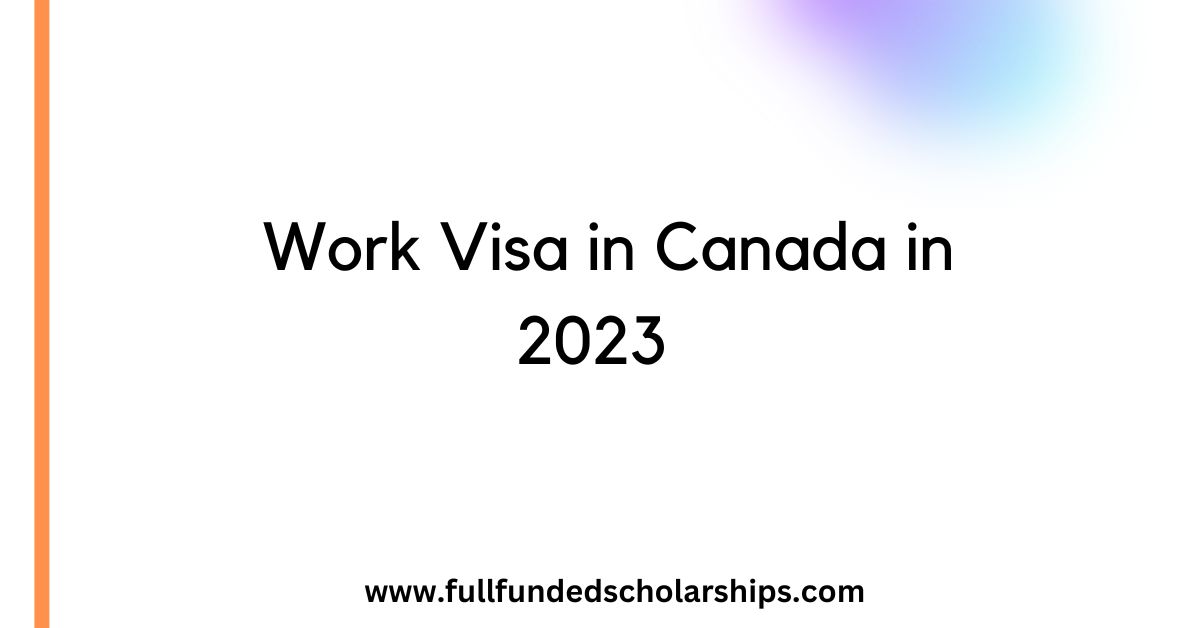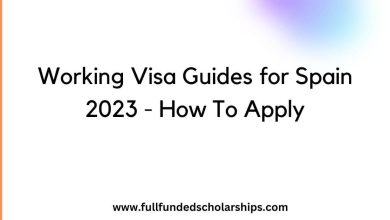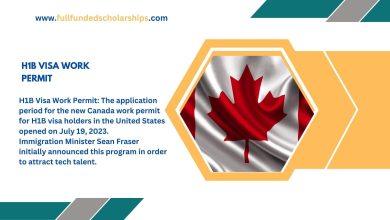Work Visa in Canada in 2023 – How To Get One

Work Visa in Canada in 2023: If you intend to work overseas in 2023, Canada is an excellent place to begin. With so many labor shortages on the market, Canada is always eager to accept foreign nationals with skills and knowledge in occupations that cannot be filled by permanent residents or Canadian citizens. Using a Canadian work visa is one way to begin your trip; however, you must first determine which visa is suitable for you.
You must apply for a Canadian work visa if you are eligible to reside and work in Canada. There are two types of work authorizations: open work authorizations and employer-specific work authorizations. Continue studying to learn how to join the thousands of newcomers who now call Canada home.
Step 1: Analysis of Varied Work Visas
Depending on what you do for a living, you can apply for one of two different types of work permits.These jobs are both an open work permit for Canada and a specific work permit for the employee.
An open work permit allows you to work for any Canadian employer, whereas a specific work permit allows you to work only for the employer specified in your work permit, which includes your name, the duration of your license, and the nature of your job.
An open work visa is ideal for those who entered Canada using the popular Express Entry system, as it permits them to live and work anywhere in Canada.
You will need an employer-specific work permit if you applied through one of the Provincial Nominee Programs, as you will only be able to work for a certain employer in a particular province or territory.
Check Also: Working Visa Information in Saudi Arabia 2023
The International Expertise Class (IEC, also known as a working tourist visa) and the International Mobility Program are two examples of common open work permit applications.A labor market impact assessment (LMIA) should not be necessary to apply for a Canadian open work visa.
Under the employer-specific work permit, multiple work visa streams exist. The employment opportunities received will determine the candidate’s best option. This work permit necessitates an LMIA.
Submit Graduate Work Allow (PGWP)
The Post-Graduation Work Permit (PGWP) was created to assist international college students who’ve graduated from a Canadian Designated Studying Establishment (DLI) with a tertiary qualification (certificate, diploma, or degree) to reside and work in Canada for as much as three years. The Canadian work permit permits a processing time of 80 to 180 days for the PGWP; therefore, early utility is essential.
As a global PGWP scholar in Canada, you can apply for an open work permit, which lets you work for any business and get the work experience you need to apply for permanent residency.
When you can only work for one employer, comparable to a construction worker, the best work permit for you is an employer-specific work permit, as you can only work for one employer and in one province.
Worldwide Expertise Canada (IEC)
International Experience Canada (IEC) gives young people the opportunity to explore Canada while working. This program offers three different streams:
Working Vacation Young Professionals Global Cooperative (Internship)
The recommended visa is the working holiday. The working holiday visa is for those who wish to earn money while visiting Canada. It is valid for 12 to 24 months, depending on the length of your stay in your home country. Only 35 nations with whom Canada has a youth mobility agreement are eligible to apply for this permit.
Momentary International Employee Program
This program assists numerous Canadian businesses in filling positions that cannot be filled by Canadian citizens or permanent residents. When a Canadian company hires a foreign national, they bring with them new skills and experiences that may not be available in Canada.
The International Expertise Stream (GTS)
The International Expertise Stream (GTS) is a government program that aims to speed up the application process for both Canadian businesses and foreign workers.The work permit processing period for this stream in Canada is less than two weeks! Applicants who have a job offer in Canada, are applying from outside Canada, and meet the standards in any of the categories listed below may apply through the International Expertise Stream. This affords Canadian businesses the opportunity to engage highly qualified temporary foreign workers in one of two categories:
Grade A
This category is for employers who have been referred by one of GTS’s 45 licensed partners and are seeking a unique and specialized international skill set.
Grade B
This class is for employers who need to fill jobs in Canada by hiring people with skills from other countries whose jobs are on the International Expertise Occupations Listing.
In-home Caregiver Stream
When Canadians and permanent residents are unavailable, the in-home caregiver’s stream allows Canadian families to hire foreign nationals who can provide care in private homes for the elderly, disabled, or disabled children. Employers may require their caregivers to live with them.
There are two types of in-home caregivers: those for persons with severe medical requirements and those for children. Uncertain which of these fits your needs? Contact an RCIC, who will guide you through the immigration routes and help you find the ideal one for your skills, experience, and education level.
Phrases it’s worthwhile to know:
Labor Market Impact Analysis (LMIA)
A “Labour Market Affect Evaluation” (LMIA) is a document issued by Employment and Social Development Canada (ESDC) to assess the effects that hiring international workers may have in Canada.
The goal of the LMIA is to ensure that all Canadians enjoy the highest possible quality of life by promoting a highly skilled labor force to strengthen the Canadian labor market.
Occupational Employment Classification (NOC)
You will need to provide your NOC code when applying for a work visa.
The National Occupational Classification (NOC) is a standard classification system in Canada that allocates a four-digit code and job description to every current occupation on the Canadian labor market.
Immigration, Refugees, and Citizenship Canada (IRCC) uses the NOC matrix to figure out if an immigrant candidate is qualified to work. The strategy makes it easier to find certified and qualified people who want to work in Canada.
Step 2: Examine Your Eligibility
If you’ve ever thought about moving to Canada, you’ve probably heard about what you need to do to get a visa.Before you apply for a temporary or permanent visa, you must find out if you are allowed to live in the country.
Given that Canada is regarded as the best place to live on the planet, followed by Japan and Germany, it is understandable that the nation has incredibly stringent procedures and rules that prevent anyone who does not meet certain requirements from entering.
Every program has its own eligibility requirements. Generally, a job offer from a Canadian employer is required to qualify for a Canadian work permit.
If you want to work for a Canadian company and need an employer-specific work visa, your Canadian employer must give you an LMIA.Once granted, include a copy with your work to facilitate application. If you are using an open work visa, there is no need to take action. If you require an LMIA, you may submit your work permit application after obtaining one.
If you apply for a part-time visa, you may also be able to obtain permits for your spouse and dependent children (over the age of 22) if they are traveling with you to Canada. This, however, depends on the office level provided to you. The higher your position, the greater the likelihood that your spouse and children will be granted an open work permit.
Unfortunately, this is not applicable to the Working Vacation visa. Your dependents cannot accompany you to Canada.
There are often a number of things to keep in mind about work visa requirements:
You should be able to demonstrate that you will leave Canada before your visa expires, which is dependent on the length of your contract. But keep in mind that you can apply for a permanent visa if you acquire valuable professional experience throughout your time working in Canada.
In addition to the work authorization you choose, you must also meet the following specific requirements when you apply for a piece permit:
- demonstrating that you have sufficient means to support yourself and your family during your stay in Canada and upon your return home.
- Provide evidence of a clean criminal record.
- Be in good health and pass a medical check with flying colors.
- Do not work for an employer who is on the list of companies that can’t handle the way people work in Canada and have been kicked off the list.
- Do not endanger Canada’s security.
- Give the officer any other proof that you are allowed to enter the country, such as a passport or travel document.
Assessing your eligibility for a particular visa is essential to the application process. Doing an analytical questionnaire and contacting a regulated Canadian immigration marketing consultant (RCIC) who is skilled in all Canadian immigration problems is the simplest way to ensure that you apply for the correct visa. They will be able to tell you precisely which visa you qualify for depending on your country of origin, skills, occupation, and the demand for your profession in Canada.
Step 3: Apply for The Appropriate Work Visa
After deciding which work permit application to fill out and making sure you meet all the requirements, you are almost ready to send in your application.
In fact, the best way to apply for a work permit in Canada is online. This can save you money on courier fees and make sure that your application is sent on time.
This will also make sure that all of the required documents are uploaded with your application, which will make it more likely that your first application will be accepted.
The processing period for Canada work permits can range from 2 to 33 weeks, but can be shortened with the assistance of a reputable RCIC that will examine your application and warn you if it requires extra information, unfilled fields, or other supporting evidence.
Contacting an RCIC will assist in accelerating the application process. This can also help you avoid making errors that may require you to resubmit your Canadian work visa application. Also, you will receive a crafted CV with your NOC skills included to facilitate your job hunt.
If you do these three things, your application for a work visa in Canada will be accepted quickly.If your application is accepted, you will get a document that says you are legally allowed to move to and work in Canada. You must show this document when you enter the country.
This letter does not represent the work that was authorized. When you arrive in Canada, you’ll usually be issued a work permit that states the type of work you’re authorized to do, the organizations or businesses you’re allowed to work for, the provinces or territories where you’re authorized to work, and the length of time you’re legally allowed to work.
With the right help and guidance during the application process for a Canadian work visa, your desire to move to Canada may become a reality. This is a risk that could lead to permanent residency in the future.
How To Apply for Work Visa in Canada in 2023 – How To Get One
If you want more details about Work Visa in Canada in 2023 use the below link
Frequently Asked Questions
-
How long does it take to get a Canadian work visa?
The processing time will depend on the completeness of your application and the office to which you submit it. It could take up to 27 weeks to process your permit application.
-
What is the overall paperwork required for a working visa in Canada?
Valid passport
Two current passport-sized photographs Academic qualification certificates
Evidence of sufficient funds
Medical examination fee for services -
How do work permits differ from Categorical Entry?
A piece visa is a temporary place to live, while Express Entry is a way for skilled professionals to apply to live in Canada permanently.





